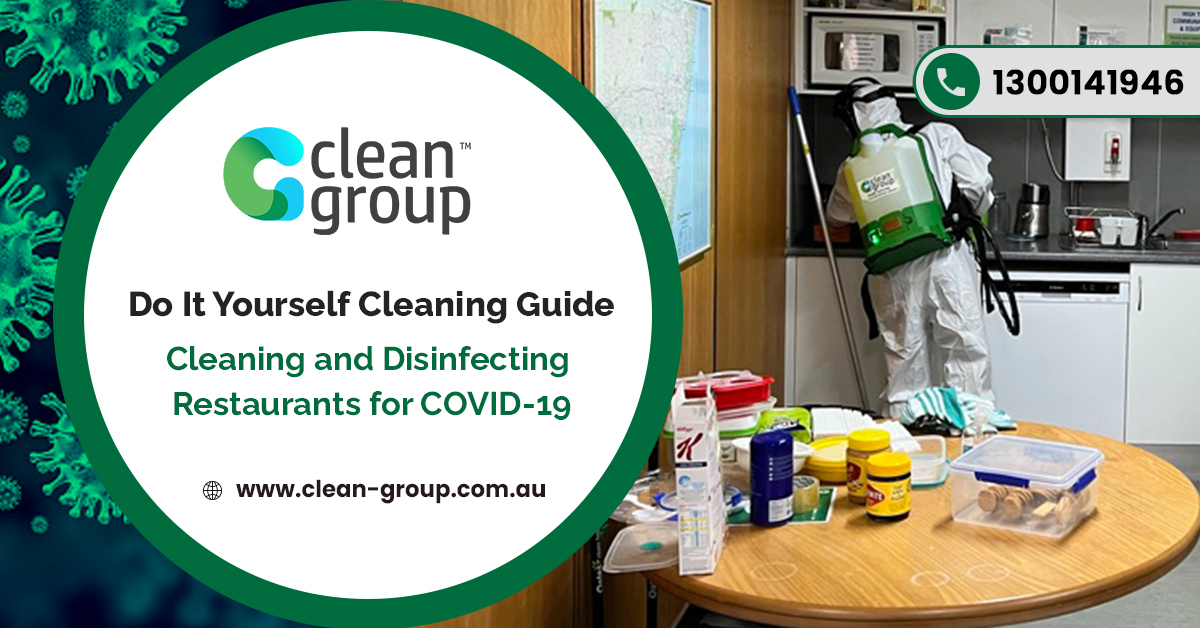Respiratory droplets produced when an infected person sneezes or coughs are the primary way that COVID-19 spreads from person to person. If someone is in close contact with an infected individual, the droplets may fall directly into the person’s mouth, nose, or eyes.
There is a greater risk of COVID-19 airborne transmission in indoor environments, especially inadequately ventilated ones. If an individual touches a contaminated surface with their hand and then touches their eyes, noses, or mouth, the virus may infect them. In this case, Covid cleaning is the best solution for all types of Covid-19 cleaning solutions
By implementing appropriate disinfecting and cleaning measures in a restaurant, you can protect your workers plus guests from the risk of exposure to COVID-19. There have been studies that show that COVID-19 can survive for long periods on a particular surface.
The most effective method of removing COVID-19 is the combination of disinfection and cleaning at least twice daily. It would be best if you implemented an appropriate disinfecting and cleaning schedule for your restaurant to remain sanitary consistently.
Today’s article shows you some of the best practices for cleaning and disinfecting your restaurant for COVID-19. We explore some of the benefits of using quality detergents and highlight the key areas that require cleaning.
Disinfecting and Cleaning Solutions
Cleaning removes viruses and bacteria from surfaces using a water-based solution and detergent. Oil and grease are easily broken up when a surfactant like a detergent is used to clean.
Disinfecting means killing bacteria and viruses using chemicals. Before commencing with a deep clean operation, it is recommended to detergent clean the area first. The reason for this is grime and dirt often hinder the ability of disinfectants to kill germs.
If you have a high volume of workers or customers that visit your establishment daily, performing a combination of disinfection and cleaning is the most effective solution.
That is especially true if there are high volume areas where customers and staff regular touch, such as the preparation table or scullery.
After a person with a suspected or confirmed case of COVID-19 has recently been to the restaurant cleaning should be undertaken immediately. The employees cleaning the contaminated area should wear appropriate PPE (personal protective equipment).
That includes eye safety goggles to protect from chemical splashes and disposable gloves. The cleaning staff should also wear a disposable apron if visible contaminations, such as bodily fluids or respiratory secretions are in the area.
Place disposable covers, PPE, and clothes in a plastic bag once disinfection and cleaning are complete. You can then dispose of it in an additional trash bag (double bagging) and throw that bag in the general waste.
It is important to remember that most disinfectants require a certain amount of time to kill viruses on the cleaned surface, and in most cases, it needs to sit for around 10 minutes before wiping it from the surface.
How to Use Disinfectants Safely
- When using disinfectants in your restaurant, it’s imperative to read the Safety Data Sheet (SDS) and follow the manufacturer’s instructions. Try your best not to mix two different disinfectants as there may be a dangerous chemical reaction.
- Your disinfectants need to be stored away from heat sources and out of direct sunlight; this ensures they are always secure and safe. A local exhaust ventilation system is recommended when using some concentrated products.
- Misting and spraying products need to be applied directly to a cleaning cloth to dampen it for use.
- Use PPE, including eye protection (safety glasses) plus gloves (elbow length if possible) when using or diluting disinfectants.
Cleaning or Disposal of PPE and Materials
Reusable items such as PPE, covers, and washable cloths should be cleaned in a regular wash cycle with normal detergent using the warmest setting possible. Before placing the items in the washing machine, please avoid shaking them out.
When handling covers, PPE, and clothes, please wear disposable gloves. Your hands need to be washed thoroughly for 20 seconds with disinfectant soap once you are complete.
The hampers in which used PPE is stored should be washed regularly, especially while the protective gear is waiting to be laundered. Use a disposable lining and replace it regularly if the hamper is not washable.
A detergent solution should be used to wipe clean reusable non-washable PPE, such as safety goggles, then afterwards clean it with disinfectant and leave it to dry. If residue or smearing occurs, you can wait for the item to dry and then clean the smudge with more detergent solution.
Standard Precautions for Cleaning Checklist
A few things should always be checked before deep cleaning your restaurant. By not following the precautions mentioned below, your team may find themselves in a situation that does not count in their favour.
- Make sure to turn off power sources and isolate electrical equipment when using liquids to clean around or on electrical fittings
- Follow the manufacturer’s recommendations and read the label of the disinfectant or detergents you are using
- Become more familiar with the contents of the detergent or disinfectant and obtain a copy of the Safety Data Sheet (SDS)
- Wear the correct personal protective equipment (PPE) identified on the SDS and visible on the label
When you follow the above precautions, you protect yourself and the cleaning staff from potentially hazardous situations.
Surface Cleaning
It is recommended to clean a restaurant’s high traffic surfaces once per day. Some circumstances may require more frequent cleaning; if the equipment is shared between kitchen staff or waiters, it should be sanitized between uses, wherever possible.
Any location where customers are touching a surface often, or many workers are using the space, should succumb to frequent disinfection. Many items in the kitchen need cleaning, and nearly all of them require that you use both a detergent cleaning solution and disinfectant for complete COVID-19 sanitation.
However, there are some exceptions to the above statement, and those are fabrics and papers. Materials like curtains or seat upholstery can be cleaned with detergents to remove stains and then steam cleaned to kill the COVID-19 virus.
We don’t use disinfectants on fabric because they contain strong chemicals that may damage the delicate material.
Another item that is not suitable for cleaning is paper. It may sound like a no-brainer, but temporary reports or cardboard surfaces do not require cleaning.
You can leave the piece of paper undisturbed for a minimum of 72 hours and then dispose of it in the bin. If these materials get dirty quickly, replacing them more often is highly recommended.
Surfaces inside of an oven or stovetops require cleaning in a manner set out in the manual of that particular piece of equipment. Follow the safety and cleaning guidelines set out by the manufacturer for the best results when disinfecting your kitchen equipment from COVID-19.
Cleaning by Item
Following a confirmed or suspected case of COVID-19 in the workplace requires that you plan routine cleaning of various items in the restaurant.
Cleaning by item is recommended for all shared workspaces, not only restaurants, so consider that when cleaning your establishment. Some things may need to be cleaned more frequently, such as cutlery, hand sanitiser dispensers, doorbells, and chairs that your patrons or staff sit on.
Most items require a detergent solution and disinfectant to clean thoroughly and remove all traces of COVID-19. Be thorough while cleaning the restaurant and ensure no object or surface is missed as the COVID-19 virus can move from area to area.
A best practice is to group items that need to be cleaned and establish a cleaning routine for them. Some may require daily cleaning, while others, like the fridge, may be better monthly.
It’s important to remember that the cleaning equipment you use to disinfect the kitchen needs to be washed too. These cleaning tools pick up dirt, grime, and germs and could transfer the COVID-19 virus to the next person who uses it.
Wash your cleaning equipment with a detergent solution and ensure thorough disinfection after every use. Maintaining a high standard in your restaurant or commercial kitchen is crucial.
Other items like your computer keyboard are sometimes forgotten when performing a restaurant clean. Cleaning the work computer once every two days is recommended to maintain a sanitised environment around the desk.
You can gently wipe down the computer with a compatible detergent solution or use 99.9% Isopropyl to disinfect it. Remember to spray it from a fine mist bottle when using Isopropyl on your keyboard or computer screen.
It is crucial to make sure that the device is switched off in case of spillage of the disinfectant solution.
By following the above guidelines for cleaning items in your restaurant’s kitchen, you can ensure that your establishment is always safe and secure.
Remember to use quality detergent and disinfectant solutions that get the cleaning job done while remaining safe for the environment.
Conclusion
The COVID-19 pandemic has ravaged the world for the last two years, and every industry has been affected by it. If you are in the restaurant business, you know how much the virus slowed down your company.
By maintaining a high cleanliness standard at your establishment, you are seen as someone who takes this pandemic seriously. You want patrons to feel safe and secure when visiting your restaurant, so make sure that you follow all the guidelines set out by Work Safe Australia.
Furthermore, not only does a sanitary restaurant attract more customers, but it keeps you and your employees safe from getting infected by the COVID-19 virus.
We hope that this article has enlightened you on the best practices for cleaning your establishment; you can now go forward and create your cleaning routine confidently.

